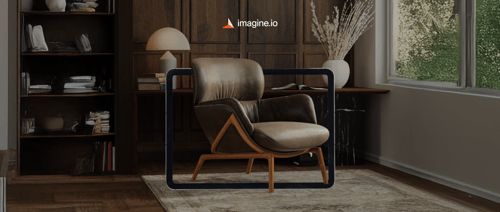AR technology revolutionizes furniture shopping by allowing customers to visualize products in their actual space before purchasing, significantly boosting confidence and reducing return rates.
Quick Listen:
Imagine standing in your cluttered living room, smartphone raised, as a elegant mid-century armchair materializes on your screen, nestled perfectly between your coffee table and window. It fits. It complements the rug. No trips to the store, no hauling heavy pieces just a tap away from certainty. This isn't science fiction; it's the reality of augmented reality (AR) reshaping how we shop for furniture today.
The Rise of AR in Furniture Retail
Augmented reality has swiftly evolved from a novelty to a cornerstone in the furniture industry, bridging the gap between online browsing and in-person certainty. As detailed in reports on the broader AR shopping landscape, the market is experiencing explosive growth. The augmented reality shopping market stood at USD 4,912 million in 2024 and is on track to reach USD 36,516.01 million by 2032, expanding at a robust compound annual growth rate of 28.5 percent over that period. This surge stems from retailers harnessing AR to enable virtual product trials, home visualizations, and tailored suggestions that not only elevate sales but also heighten customer contentment.
What fuels this momentum? The ubiquity of smartphones equipped for AR, coupled with leaps in software and hardware, plays a pivotal role. E-commerce's ascent and consumer's craving for fresh, engaging shopping encounters compel retailers to weave AR into their digital fabrics. In regions like North America and Europe, where tech uptake is swift and major retailers pour resources into AR, the market leads the charge. Meanwhile, Asia Pacific nations such as China, Japan, and South Korea surge ahead, propelled by tech-enthusiast consumers and a thirst for digitized, dynamic retail interactions.
Beyond general shopping, AR's footprint in e-commerce sharpens the focus. The global augmented reality in e-commerce sector hit USD 5,878.8 million in 2024, poised to climb at a 35.8 percent CAGR from 2025 to 2030, potentially hitting USD 38,548.9 million. North America commands over 25 percent of this share, with the U.S. market alone eyeing a CAGR exceeding 21 percent through 2030. Hardware leads with more than 58 percent market share, head-mounted displays topping segments, and virtual try-on solutions reigning supreme. These figures underscore how widespread smartphone adoption and hefty investments from e-commerce behemoths accelerate AR's reach, making personalized, interactive shopping the norm.
Emerging Trends Driving Adoption
Trends in 2025 paint a vivid picture of AR's integration. Gartner predicts 80 percent of retail brands will deploy AR for customer engagement this year, encompassing 3D product views and immersive trials. In furniture specifically, tools like AR visualizations tackle longstanding pain points mismatched scales, clashing styles turning hesitant browsers into decisive buyers. Sustainability also factors in, as digital previews cut down on physical returns, aligning with eco-conscious trends sweeping the sector.
Projections for the augmented reality market at large bolster this, valuing it at USD 83.65 billion in 2024 and forecasting a leap to USD 599.59 billion by 2030 at a 37.9 percent CAGR. Retail applications shine here, with AR fostering virtual try-ons and home previews that spike engagement and sales. Asia Pacific is set to grow fastest at over 41 percent CAGR, thanks to digital shifts and smartphone proliferation.
Seeing Is Believing: How AR Works
At its core, AR superimposes digital elements onto the physical world via device cameras, transforming furniture shopping from abstract to tangible. Shoppers aim their phones at a space, and voila a virtual bedframe appears, scaled accurately with shadows and lighting rendered realistically. Pioneering this is IKEA's ecosystem, built on Apple's ARKit, which democratizes AR for everyday users.
The IKEA Place app, for instance, empowers users to "try on" furnishings at home, scaling items with 98 percent precision and simulating real-world conditions. As Michael Valdsgaard, Inter IKEA's digital transformation leader, articulates, many hesitate over furniture changes fearing errors, but AR instills assurance by letting them experiment with styles, hues, and layouts amid existing setups. He praises Apple's breakthroughs in AR hurdles, positioning ARKit as a tool for practical, accessible decision-making.
Wayfair echoes this with its "View in Room" feature, enabling real-time previews adjustable for position and ambiance. Such tools extend beyond visuals, offering metrics and style tips that demystify purchases. In essence, AR eradicates guesswork, curbing the high return rates plaguing furniture e-commerce.
Real-World Impact: Case Studies in Confidence
IKEA's AR odyssey started ambitiously, aiming to simplify furniture decisions like outfit trials. Debuting in 2017, IKEA Place has matured into a digital staple, boasting thousands of scannable products from sofas to shelving. Its ease scan, select, place has earned acclaim as an industry disruptor. Fast-forward to 2025, IKEA unveiled the IKEA 3D Experience in February, amplifying immersive home shopping with enhanced 3D modeling.
Wayfair keeps pace, its AR app permitting virtual placements of lamps or sectionals, tunable for lighting variances. This builds trust; visualizing erases doubts, slashing regrets. Broader adoption spans Amazon to niche outlets, all leveraging AR for captivating experiences.
E-commerce AR's trajectory reinforces this, with virtual try-ons dominating segments. Investments flourish, from Google's March 2025 Wiz acquisition bolstering AR cloud security to Snap's AI-infused AR tools curbing returns. Furniture-specific insights reveal 61 percent of online shoppers favor AR-equipped retailers, and 71 percent would frequent them more, per recent studies.
Other apps like Houzz and Home Depot join the fray, offering AR previews that personalize interiors. GlamAR stands out in 2025 for unique furniture trials, while Pepperly blends innovation with vast selections. These evolutions signal AR's maturation, blending seamlessly across platforms like ARKit, ARCore, and WebAR.
Boosting Sales Through Immersion
Evidence mounts: AR users convert at higher rates. Retailers report dwindled returns up to 58 percent reductions projected for 2025 as previews align expectations with reality. This efficiency saves costs, from logistics to inventory, while fostering loyalty through memorable interactions.
The Challenges: Not All Smooth Surfaces
Yet AR's path isn't seamless. Device compatibility poses barriers; not all phones boast the prowess for fluid AR, demanding potent processors and crisp cameras. Connectivity woes spotty internet can glitch experiences, frustrating users mid-preview.
Educating consumers remains key. Tech natives embrace AR swiftly, but others require intuitive guides and demos. Retailers must craft user-centric apps to avoid alienation. Tactile gaps persist too; AR visualizes but can't convey texture or comfort, preserving showroom's allure for final touches.
Implementation costs challenge smaller players, though declining hardware prices and cloud solutions mitigate this. Privacy concerns and data security also loom, especially with room scans revealing personal spaces.
Opportunities: Building a Better Shopping Experience
AR's upsides eclipse hurdles, revolutionizing online furniture hunts by quelling uncertainties. Confident shoppers buy more, as AR previews correlate with elevated conversions. The augmented reality shopping market's drivers tech advances, e-commerce booms amplify this, with over 60 percent of global e-tailers adopting AR.
For businesses, AR trims expenses on physical displays and staging while paradoxically boosting store visits; digital teasers lure customers for hands-on confirms. Hybrid models thrive, merging virtual and real.
Looking ahead, synergies with AI promise hyper-tailored recommendations, while VR integrations could spawn full virtual showrooms. Government backing, like U.S. allocations exceeding $400 million for AR R&D, accelerates innovation.
In furniture, AR curbs returns a notorious drain by ensuring fits. Projections for 2025 highlight 32 percent of consumers routinely using AR shopping, underscoring its entrenchment.
A Memorable The Future of Furniture Shopping
As the furniture realm navigates tech and tradition's intersection, AR emerges as a transformative force, empowering buyers and redefining retail dynamics.The AR e-commerce market is gaining strong momentum, reflecting the broader surge in augmented reality adoption across industries.
Yet, it's the human element banishing doubt, sparking joy in discovery that truly captivates. In this evolving landscape, AR doesn't just sell furniture; it crafts homes. So, next time a piece catches your eye, don't merely ponder augment your reality and witness the fit. The future, after all, overlays seamlessly on the present.
Frequently Asked Questions
How does augmented reality help customers buy furniture online with more confidence?
Augmented reality allows customers to visualize furniture pieces in their actual living spaces using their smartphone cameras, with up to 98% accuracy in scaling and realistic lighting effects. This technology eliminates guesswork by letting shoppers see exactly how items will look and fit in their homes before purchasing. AR significantly reduces return rates with projections showing up to 58% reductions in 2025 because customers can make informed decisions based on realistic previews rather than product photos alone.
Which furniture retailers offer AR shopping features and how do they work?
Major furniture retailers like IKEA, Wayfair, Amazon, Home Depot, and Houzz now offer AR shopping capabilities through their mobile apps. IKEA's Place app, built on Apple's ARKit, allows users to scan and place thousands of furniture items in their rooms with realistic shadows and lighting. Wayfair's "View in Room" feature enables real-time furniture placement with adjustable positioning and ambient lighting, while apps like GlamAR and Pepperly offer unique AR furniture trials across various platforms including ARKit, ARCore, and WebAR.
What are the main challenges and limitations of using AR for furniture shopping?
The primary challenges include device compatibility issues, as not all smartphones have the processing power and camera quality needed for smooth AR experiences. Connectivity problems with spotty internet can cause glitches during previews, and many consumers still need education on how to use AR features effectively. Additionally, AR can visualize furniture but cannot convey physical qualities like texture or comfort, which is why many customers still visit showrooms for final confirmation before major purchases.
Disclaimer: The above helpful resources content contains personal opinions and experiences. The information provided is for general knowledge and does not constitute professional advice.
You may also be interested in: How 3D Rendering Can Make or Break Your Industrial Design Pitch
Struggling with expensive, outdated product visuals that slow down your creative process and stunt eCommerce growth? imagine.io's AI-powered platform empowers furniture, home décor, and textile brands to effortlessly produce striking 3D images, immersive videos, AR experiences, and interactive configurators. Cut production costs up to 70%, boost conversions 5X, speed up prototyping, and supercharge your online sales. Ready to elevate your product visuals and captivate customers? Book a demo with imagine.io today!
Powered by flareAI.co




.png?width=500&name=How%20to%20Add%20a%203D%20Product%20Configurator%20to%20Your%20WordPress%20Website%20(Complete%20B2B%20Guide).png)
















%20(1).png?width=500&name=Why%20Exploded%20Mattress%20Views%20Matter%20(And%20How%20to%20Generate%20Them)%20(1).png)
.png?width=500&name=Best%20Shopify%20Product%20Configurator_%20How%20to%20Choose%20the%20Right%20One%20(2).png)
.png?width=500&name=Why%20Exploded%20Mattress%20Views%20Matter%20(And%20How%20to%20Generate%20Them).png)



.png?width=500&name=Best%20Shopify%20Product%20Configurator_%20How%20to%20Choose%20the%20Right%20One%20(1).png)







.png?width=500&name=How%203D%20Rendering%20Can%20Make%20or%20Break%20Your%20Industrial%20Design%20Pitch%20(1).png)








%20with%20Digital%20Twins%20and%203D%20Visualization.png?width=500&name=Optimizing%20Your%20Digital%20Asset%20Management%20(DAM)%20with%20Digital%20Twins%20and%203D%20Visualization.png)




.png?width=500&name=Styling%20Home%20Decor%20for%202025_%20From%20Global%20Influences%20to%20Playful%20Personalization%20(1).png)
